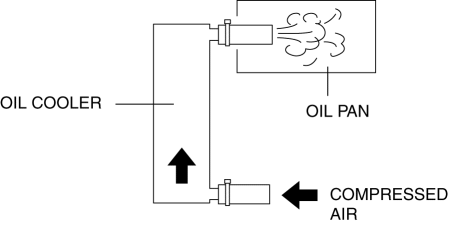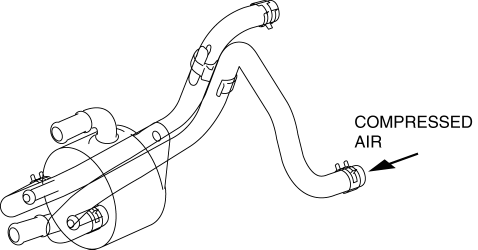Mazda 3 Service Manual: Oil Cooler Flushing [FS5 A EL]
NOTE:
-
If the automatic transaxle is replaced, flush and inspect the oil cooler.
-
When replacing the automatic transaxle, inspect the oil cooler together with flushing it using the following procedures, and with the oil cooler hose removed.
1. Disconnect the oil hose.
2. Set a clean oil pan up to the oil hose inlet.

3. Blow 491—882 kPa {5—9 kgf/cm2, 72—127 psi} of compressed air into the oil hose outlet to drain remaining oil.

4. Add new ATF from the oil cooler hose outlet and blow 491—882 kPa {5—9 kgf/cm2, 72—127 psi} of compressed air to flush. (Repeat 2 or 3 times)
5. Verify that none of the following foreign material is mixed in with the drained ATF:
-
Large metal fragments of φ 0.5 mm {0.02 mm} or more that cannot pass through the oil strainer
-
Fibrous clutch facing
6. Repeat the procedures from Step 4 and flush the inside of the oil cooler.
-
If foreign material such as metal fragments or clutch facing remains even after the oil cooler is flushed repeatedly, replace the oil cooler.
 Oil Control Valve (OCV) Removal/Installation [Mzr 2.0, Mzr 2.5]
Oil Control Valve (OCV) Removal/Installation [Mzr 2.0, Mzr 2.5]
1. Remove the battery cover..
2. Disconnect the negative battery cable..
3. Remove the plug hole plate..
4. Disconnect the wiring harness.
5. Remove the ignition coils..
6. Remove the ventil ...
 Oil Cooler Removal/Installation [FS5 A EL]
Oil Cooler Removal/Installation [FS5 A EL]
1. Remove the battery cover..
2. Disconnect the negative battery cable.
3. Remove the air cleaner component..
4. Remove the aerodynamic under cover NO.2..
5. Drain the ATF..
6. Drain the eng ...
Other materials:
Front Seat Belt Pretensioner and Load Limiting Systems
For optimum protection, the driver and
front passenger seat belts are equipped
with pretensioner and load limiting
systems. For both these systems to work
properly you must wear the seat belt
properly.
Pretensioners:
When a collision is detected, the
pretensioners deploy simultaneously wit ...
Driving Tips
WARNING
Do not let the vehicle move in a
direction opposite to the direction
selected by the selector lever:
Do not let the vehicle move backward
with the selector lever in a forward
position, or do not let the vehicle
move forward with the selector lever
in the revers ...
Parking Brake
CAUTION
Driving with the parking brake on
will cause excessive wear of the brake
parts.
NOTE
For parking in snow, refer to Winter Driving regarding parking
brake use.
Setting the parking brake
Depress the brake pedal and then firmly
pull the parking brake lever fully upwar ...
